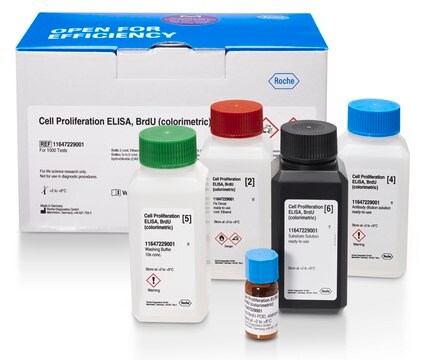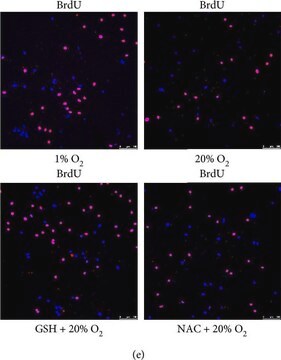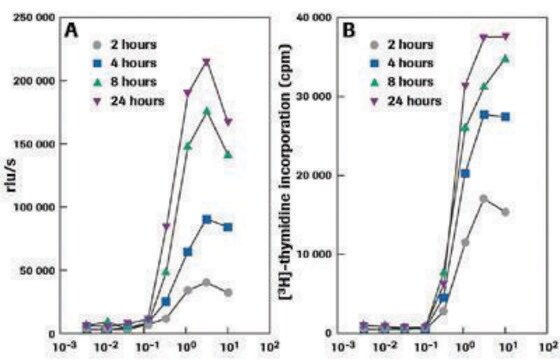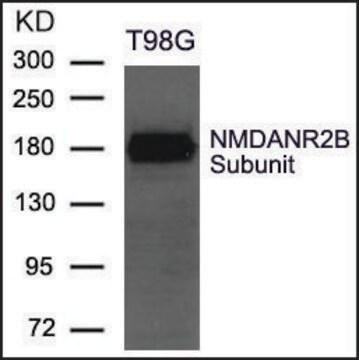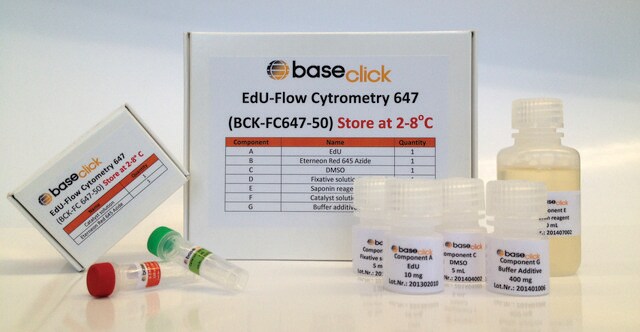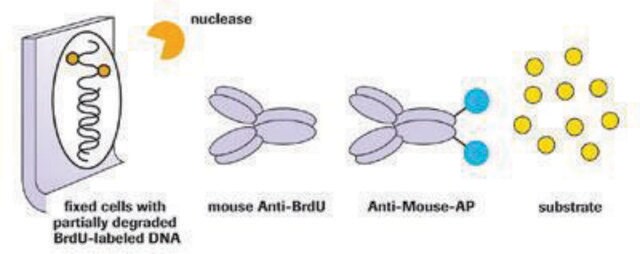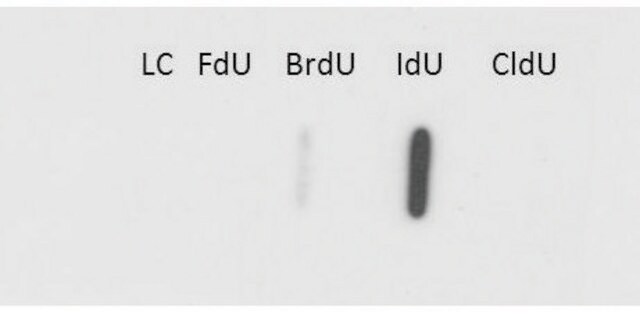추천 제품
생물학적 소스
mouse
Quality Level
결합
unconjugated
항체 형태
purified immunoglobulin
항체 생산 유형
primary antibodies
클론
BMC9318, monoclonal
분석
90% (HPLC and SDS-PAGE)
형태
solution
포장
pkg of 50 μg (500 μl)
제조업체/상표
Roche
동형
IgG1
저장 온도
−20°C
일반 설명
Anti-Bromodeoxyuridine is a monoclonal antibody to 5-bromo-2′-deoxyuridine-5′-monophosphate.
특이성
The antibody specifically binds to bromodeoxyuridine and crossreacts with iodouridine (10%). Anti-bromo-deoxyuridine does not crossreact with fluorodeoxy-uridine, nor with any endogenous cellular components such as thymidine or uridine.
면역원
The epitope is apparently inside the DNA helix. DNA has to be denatured to ssDNA before antibody efficiently binds to DNA-BrdU.
애플리케이션
Anti-bromodeoxyuridine (Anti-BrdU) antibody is suitable for monitoring proliferating cells in blood, tissues, and tumors, as well as for determining BrdU incorporation on a single-cell level using:
- Flow cytometry
- Immunohistocytochemistry
- Cryosections
- Paraffin sections
품질
The antibody is ≥90% pure as determined by SDS-PAGE with Coomassie-blue staining, and by HPLC.
규격
Preparation: BALB/c mice were immunized with a bromodeoxyuridine-bovine serum albumin conjugate. Lymphocytes isolated from the spleen were fused with Ag8.653 myeloma cells to create the BMC 9318 clone. The antibody was produced in ascites in BALB/c mice and purified by ion-exchange chromatography.
No. of tests: 250 (Flow cytometry)
No. of tests: 250 (Flow cytometry)
물리적 형태
Solution, stabilized with phosphate buffered saline, pH 7.4, containing 0.09% (w/v) sodium azide and 0.2% (w/v) gelatin.
제조 메모
Working concentration: Flow cytometry: 2 μg/ml (0.2 μg/100 μl/106 cells); Immunohistocytochemistry: 6 μg/ml
Working concentration of conjugate depends on application and substrate. Dilutions should be made in PBS (pH 7.4) containing 0.1% BSA to maintain stability of the antibody.
Working concentration of conjugate depends on application and substrate. Dilutions should be made in PBS (pH 7.4) containing 0.1% BSA to maintain stability of the antibody.
분석 메모
Anti-Bromodeoxyuridine shows 10% cross reaction with iodo-deoxyuridine, but no cross reaction to fluoro-deoxyuridine.
No cross reaction to any endogenous thymidine or uridine.
Cross reactivity with 5-Br-UTP has not been tested but it is suggested that there is a good chance for reaction, because the only difference is an absent hydroxyl group on the ribose distal to the bromine substitution.
No cross reaction to any endogenous thymidine or uridine.
Cross reactivity with 5-Br-UTP has not been tested but it is suggested that there is a good chance for reaction, because the only difference is an absent hydroxyl group on the ribose distal to the bromine substitution.
기타 정보
For life science research only. Not for use in diagnostic procedures.
적합한 제품을 찾을 수 없으신가요?
당사의 제품 선택기 도구.을(를) 시도해 보세요.
Storage Class Code
12 - Non Combustible Liquids
WGK
nwg
Flash Point (°F)
No data available
Flash Point (°C)
No data available
시험 성적서(COA)
제품의 로트/배치 번호를 입력하여 시험 성적서(COA)을 검색하십시오. 로트 및 배치 번호는 제품 라벨에 있는 ‘로트’ 또는 ‘배치’라는 용어 뒤에서 찾을 수 있습니다.
이미 열람한 고객
Derek C Adams et al.
American journal of physiology. Renal physiology, 297(3), F809-F815 (2009-06-19)
Long-term pulse chase experiments previously identified a sizable population of BrdU-retaining cells within the renal papilla. The origin of these cells has been unclear, and in this work we test the hypothesis that they become quiescent early during the course
Wouter Laurentius Smit et al.
Proceedings of the National Academy of Sciences of the United States of America, 117(41), 25560-25570 (2020-09-30)
Deregulated global mRNA translation is an emerging feature of cancer cells. Oncogenic transformation in colorectal cancer (CRC) is driven by mutations in APC, KRAS, SMAD4, and TP53, known as the adenoma-carcinoma sequence (ACS). Here we introduce each of these driver
Erika A Correll et al.
IBRO neuroscience reports, 10, 31-41 (2021-04-17)
It has been demonstrated that adult born granule cells are generated after traumatic brain injury (TBI). There is evidence that these newly generated neurons are aberrant and are poised to contribute to poor cognitive function after TBI. Yet, there is
Xuexiao Li et al.
Cell death discovery, 8(1), 323-323 (2022-07-17)
Myelodysplastic syndromes (MDS) are characterized by daunting genetic heterogeneity and a high risk of leukemic transformation, which presents great challenges for clinical treatment. To identify new chemicals for MDS, we screened a panel of FDA-approved drugs and verified the neutrophil
Victoria Sofía Berenice Wies Mancini et al.
Glia, 67(2), 291-308 (2018-11-21)
Multiple sclerosis (MS) is one of the most common causes of progressive disability affecting young people with very few therapeutic options available for its progressive forms. Its pathophysiology involves demyelination and neurodegeneration apparently driven by microglial activation, which is physiologically
자사의 과학자팀은 생명 과학, 재료 과학, 화학 합성, 크로마토그래피, 분석 및 기타 많은 영역을 포함한 모든 과학 분야에 경험이 있습니다..
고객지원팀으로 연락바랍니다.